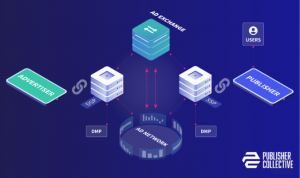Adtech 101: The Beginner’s Guide for Publishers

Every pageview on your site is a missed opportunity if you’re not capturing its full value. Too often publishers rely on a handful of direct deals or a single ad network that pays well below market rates. Modern adtech changes that by running automated, real‑time auctions across dozens of buyers, so you see the highest bid every time instead of settling for the lowest common denominator.
In this guide you’ll discover how those auctions work, meet the platforms that power them and learn exactly what to do first to turn more of your inventory into reliable revenue.
What Is Ad Tech?
Short for advertising technology, ad tech (or adtech) is the broad ecosystem of platforms, data, and processes that power every step of digital advertising, from selling and buying inventory to serving and measuring ads. If you want to turn your website real estate into reliable revenue, ad tech is the system that makes it happen.
At its core, adtech answers two key questions for every publisher:
- Who is buying your ad space? Supply-side platforms (SSPs) organize, package, and present your available inventory to potential buyers.
- How do those buyers place bids? Demand-side platforms (DSPs) allow advertisers to automatically bid on impressions in real time, ensuring your best placements get maximum attention.
Between these two sits the ad exchange, a virtual auction house where impressions are bought and sold in milliseconds. Data management platforms (DMPs) feed audience insights into the process, so advertisers know they are reaching the right viewers and you can boost your effective CPM.
With adtech in place, you can:
- Automate ad sales to save time and reduce manual work
- Optimize yield on each impression for higher revenue
- Gain transparent insights into who is buying your ad space and at what price
Adtech includes both traditional, direct ad sales, where you negotiate fixed deals, and automated, auction-based transactions, known as programmatic advertising. In the next section, we’ll zoom in on programmatic, the fastest-growing way to sell impressions.
To dive deeper into how programmatic buying works, check out our Beginner’s Guide to AdTech.
Programmatic Advertising Basics
Programmatic advertising sits at the heart of modern adtech, using software to buy and sell impressions in the time it takes a page to load. Think of it as an always-on marketplace: instead of manually negotiating deals with individual advertisers, you tap into a pool of buyers who bid for your inventory automatically.
Unlike direct ad sales, where you agree on a fixed rate and placement, programmatic values each impression in real time. When a visitor arrives on your site, demand-side platforms evaluate data like location, browsing history, or device type to decide how much they’re willing to pay. That bid travels through an ad exchange, and the highest offer wins the impression.
There are a few ways you can set this up:
- In an open auction (RTB), any qualified buyer can bid on your impressions, maximizing competition.
- A private marketplace (PMP) restricts access to select advertisers, giving you more control over brand safety and pricing.
- Programmatic direct combines the certainty of negotiated deals with the efficiency of automated delivery, no auction required.
Header bidding is a popular enhancement: by sending your inventory to multiple sellers before your main ad server fires, you invite simultaneous bids and often see higher effective CPMs.
Programmatic may sound complex, but once it’s live, it frees up your team from manual order management and helps you earn more on every impression. To explore how it works in depth, visit our Understanding Programmatic Advertising guide.
Who’s Who in AdTech
Before you dive into auctions and real-time bidding, it helps to picture adtech as a digital marketplace where each platform plays a distinct role. Think of DSPs, SSPs and exchanges as stalls in a bazaar, each handling a different part of the buying and selling process.
What Is a Demand‑Side Platform (DSP)?
A demand‑side platform is the advertiser’s control centre. In one place, buyers set budgets, choose audiences and launch campaigns across multiple sites. When an impression becomes available, the DSP evaluates data such as location, device and browsing history to decide how much to bid. Understanding DSP logic helps you package your inventory in ways that attract higher bids.
What Is a Supply‑Side Platform (SSP)?
On the publisher side, a supply‑side platform takes your available impressions (the ad slots on your pages), applies rules like minimum bids or brand safety filters, and sends them to ad exchanges and DSPs for auction. With an SSP, you centralise inventory management, improve your fill rate (the percentage of ad slots you actually sell) and boost your effective CPM.
What Is an Ad Exchange?
An ad exchange acts as the virtual auction house between SSPs and DSPs. When your SSP sends a bid request, any connected DSP can offer a price in real time. The exchange compares those bids and awards the impression to the highest bidder, all in under a second. For a deeper look at how these auctions unfold, check out How Do Ad Exchanges Work?.
What Is an Ad Server?
An ad server stores your creative assets (your banner images, video files and other ad formats), tracks impressions and makes sure ads display correctly on your site. It handles delivery reporting, viewability, click‑through rate and more, but does not run auctions. You may choose a standalone ad server for extra analytics or use the built‑in option in larger platforms. We’ll cover ad servers in more detail in a future deep dive.
What Is Header Bidding?
Header bidding is an enhancement that sends your inventory to multiple SSPs and exchanges before your primary ad server makes its call. This simultaneous bidding process replaces the traditional waterfall auction, inviting more competition and often driving higher revenue per impression. For setup tips and best practices, see our What Is Header Bidding? Guide.
Key Ad Tech Metrics Explained
Before you can boost revenue, you need to understand the dashboard of metrics that track ad performance on your site. These six figures will show you where you’re earning well and where you might improve.
- CPM (Cost per Thousand Impressions): The price an advertiser pays for 1,000 ad impressions (the “M” comes from the Latin word mille, meaning thousand). Use CPM to compare baseline rates across different demand partners.
- eCPM (Effective CPM): Your actual earnings per 1,000 ad impressions, calculated by dividing total ad revenue by total impressions and then multiplying by 1,000. eCPM lets you translate mixed revenue sources, like direct deals and programmatic bids, into a single, apples‑to‑apples figure.
- RPM (Revenue per Thousand Pageviews): Similar to eCPM but based on pageviews instead of ad impressions. RPM shows how much you earn for every 1,000 pageviews, regardless of how many ads each page serves.
- Fill Rate: The percentage of ad requests that actually return an ad. If you make 100 ad requests and receive 80 ads, your fill rate is 80 percent. A low fill rate means you’re leaving inventory unsold.
- Viewability: The share of delivered ads that meet the minimum criteria to be counted as “seen,” typically defined as 50 percent of pixels in view for at least one second. Higher viewability means advertisers get more exposure and may pay premium rates.
- Latency: How long it takes for an ad to load and display. High latency can harm user experience, reduce viewability and cost you revenue in the long run.
How Does Ad Tech Work?
Understanding how ads move from an available slot on your site to a fully loaded creative can feel overwhelming, but seeing the full sequence helps you spot where to optimize and what tools to configure. From request to payout, each step offers an opportunity to boost revenue, improve load times and ensure a smooth user experience.
Now, imagine a visitor named Alice lands on your page. In the blink of an eye, literally under half a second, an entire ad‑tech marketplace springs into action to find the highest‑paying ad for her to see. Here’s how it unfolds:

- Page request & header wrapper (optional)
Alice’s browser asks for the page and any ads on it. If you’ve implemented header bidding, a lightweight script in your page header fires first, sending simultaneous bid requests to multiple SSPs and exchanges. This “pre‑auction” step gives all partners a shot before your main ad server calls. - Standard bid request
Next, your supply‑side platform packages the ad slots and sends them to an ad exchange, unless a header wrapper already delivered a winning bid. Either way, the exchange now holds one or more potential prices. - DSPs evaluate and return bids
Demand‑side platforms review each bid request, apply data about Alice (location, device, interests) and instantly decide how much they’re willing to pay. Those bids fly back through the exchange (or into your header wrapper). - Auction and winner selection
The exchange (or your ad server, if you’re comparing a header bid against a traditional waterfall) evaluates all offers. The highest bid wins the impression in under 300 milliseconds. - Ad delivery
The winning creative, whether it’s an image, video or rich‑media file, loads from your ad server and displays in Alice’s browser. - Measurement and payout
As Alice views or interacts with the ad, your ad server tracks impressions, viewability and clicks. Your SSP records the final bid price, credits your account, and updates your effective CPM and overall earnings.
Why add header bidding? By inviting multiple SSPs and exchanges to bid in parallel, header bidding often surfaces a higher “first‑look” price. Your ad server then only needs to compare that header bid against its waterfall, and you frequently see better revenue on every impression.
With this automated flow in place, you eliminate manual order management and unlock real‑time data on who’s buying your space and for how much. Next up, we’ll walk through choosing and configuring these tools to fit your site’s needs.
How Targeting and Cookies Affect Your Ad Revenue
In programmatic advertising, relevance translates directly into revenue. The more accurately your ads match your audience’s interests, the higher advertisers are willing to bid, resulting in increased CPMs. But how exactly does this targeting happen, and what’s changing in the landscape of ad personalization?
Traditionally, targeting has relied heavily on third-party cookies, small files stored in a visitor’s browser that track their browsing habits across multiple sites. Advertisers use this data to build detailed profiles, delivering personalized ads that command higher prices.
However, growing privacy concerns and evolving regulations, such as GDPR and the California Consumer Privacy Act (CCPA), have led to major shifts in how data can be collected and used. Major browsers, including Chrome and Safari, are phasing out support for third-party cookies, fundamentally changing how targeting works.
For publishers, this means adapting quickly to maintain ad revenue:
- Embrace First-party Data: Collect your own visitor data (like email addresses, on-site interactions, and subscriber preferences). This data remains compliant with regulations, gives advertisers valuable insights, and can even increase your ad rates.
- Leverage Contextual Targeting: Contextual targeting matches ads to the content of your pages rather than relying on user behavior. If your content is about gaming, for instance, gaming-related ads will naturally perform better, boosting your CPMs.
- Prioritize User Consent: Clearly communicate your data collection policies to visitors and implement transparent consent mechanisms. This builds trust, ensures compliance, and maintains advertiser confidence.
By proactively adapting to these changes, you’ll maintain and potentially even grow your ad revenue despite the evolving privacy landscape.
Getting Started with AdTech as a Publisher
Jumping into adtech can feel overwhelming, but you don’t have to master everything at once. Many publishers begin with a simple setup and then evolve as they grow. Here’s a roadmap for your first steps.
Start with Google AdSense
For complete beginners, Google AdSense is the easiest way to monetize. You paste a snippet of code on your site, and Google matches ads to your content and audience. There is virtually no technical setup beyond placing the tags, and you get access to Google’s full pool of advertisers. The trade‑off is that AdSense yields can be lower than more advanced setups and you won’t control header bidding or negotiated deals yet. Think of it as your launchpad to get some baseline revenue and learn how ad reporting works before you level up.
Managed AdTech Solutions
If you’d rather skip the technical heavy lifting, a managed partner handles integrations, optimization and reporting on your behalf. They set up header bidding wrappers, connect with SSPs, negotiate PMP deals and tweak floor prices over time. That saves your team countless hours but typically costs a revenue share or a monthly fee. Publisher Collective offers hands‑on ad tech management tailored to your site, from choosing the right SSPs to fine‑tuning all monetization settings, so you can focus on content while we run the auctions.
DIY AdTech Setup
Going DIY gives you full control and keeps 100 percent of your revenue, but it demands time and technical know‑how. You’ll need to:
- Manage relationships with multiple SSPs and negotiate private marketplace deals.
- Configure and maintain Prebid.js wrappers, updating modules and versions whenever partners change requirements.
- Set and test floor prices for each demand source to balance fill rate against eCPM.
- Troubleshoot latency issues, tag conflicts and reporting discrepancies as you add new bidders.
DIY is a powerful option once you have a developer or ad ops specialist on hand, but it can be a steep learning curve for small teams.
What Small‑to‑Medium Publishers Should Prioritize
To build a solid foundation, focus on these essentials first:
- Implement a lightweight header bidding wrapper to invite multiple bids in parallel
Choose SSPs with transparent reporting and easy payment terms - Set up a simple dashboard tracking CPM, eCPM and fill rate so you know where you stand
- Make one change at a time—add a new bidder or adjust a floor price and measure the impact
Whether you start with AdSense, partner with a managed provider or dive into DIY, these priorities will keep you on track. When you’re ready to scale, Publisher Collective can help you design and execute a custom ad tech strategy that maximizes your revenue and minimizes your workload.
Conclusion
Ad tech doesn’t have to be intimidating. You now understand what it is, how programmatic auctions work, who the main players are and which metrics drive your revenue. You’ve seen the pros and cons of starting with AdSense, managing your own stack or working with a partner.
If you’re ready to simplify your monetization and boost your earnings, let’s talk. The Publisher Collective team combines hands‑on ad tech expertise with a publisher‑first approach to help you set up, optimize and scale your ad strategy. Get in touch today to see how we can turn your traffic into reliable revenue.

